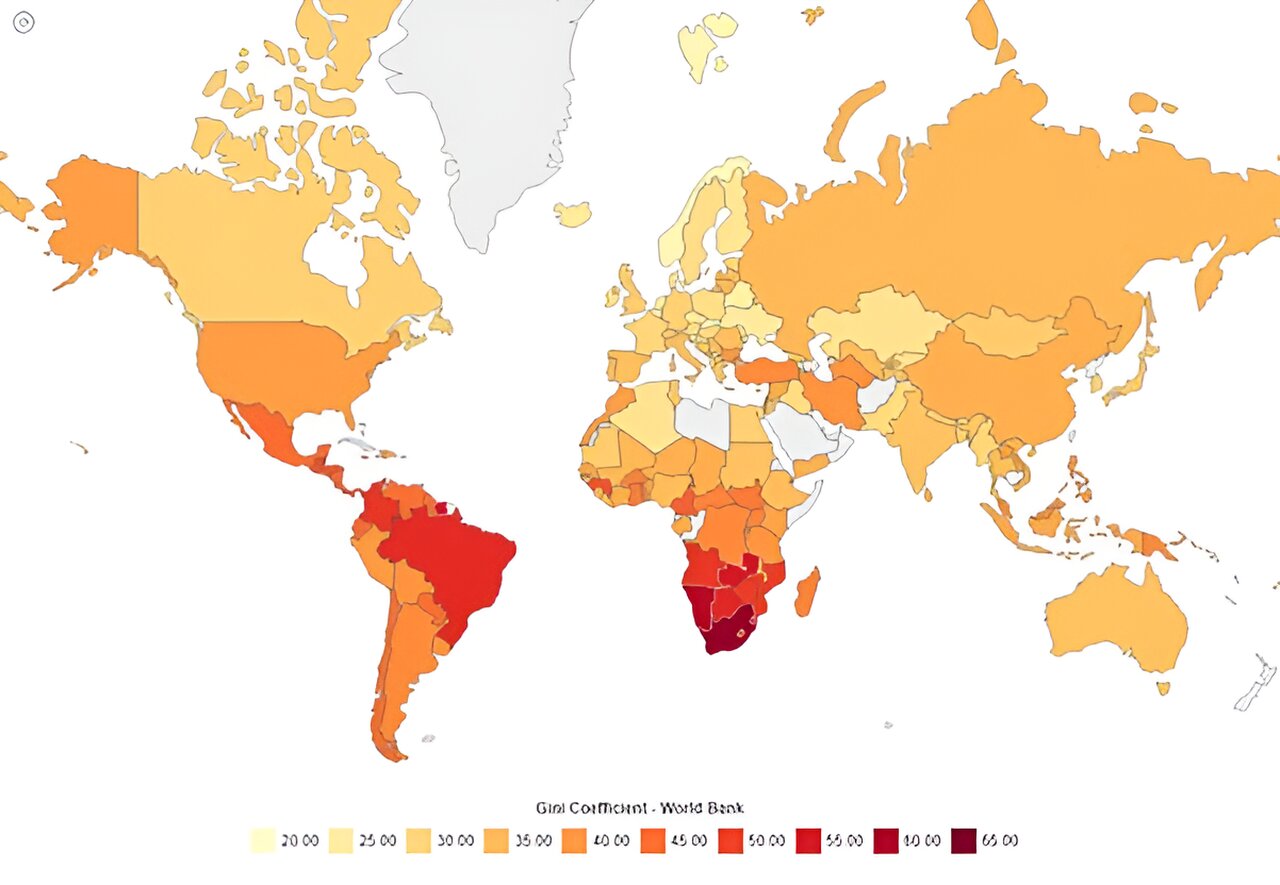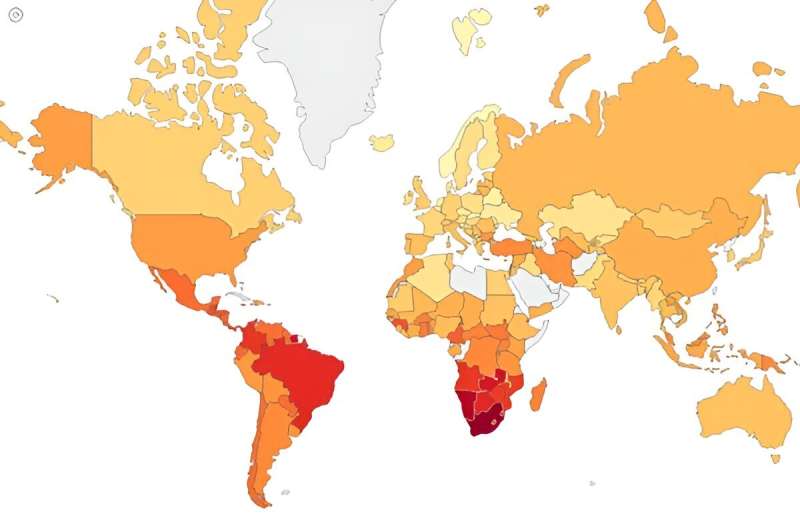

Inequality among people has become an increasingly salient issue globally, with data indicating a rise in inequality levels across many countries in recent years. This, in turn, has generated concerns both from the perspective of the sustainability of economic growth, as well as from the perspective of social cohesion and well-being.
One of the pivotal tools in understanding and quantifying this inequality is the Gini index, also known as the Gini coefficient, a measure of statistical dispersion commonly used to denote income or wealth inequality within a nation or a specific social group.
In a recent research work, we delved into the modern views and applications of the Gini index, highlighting its advantages, disadvantages, and relevance in different settings, while also exploring its implications for international diplomacy and policymaking. The work was published in Modern Indices for International Economic Diplomacy.
The Gini index: A measure of socio-economic inequality
The image above provides a visual representation of Gini indices by country as of 2024, where higher values indicate greater income inequality. It can be easily observed that South Africa holds the lowest position globally in terms of income equality, while Nordic and Central Eastern European nations dominate the top 10 rankings. In Europe, inequality tends to be lower compared to other regions, with Slovenia recording the world’s smallest Gini ratio.
The Gini index, while traditionally associated with economics, has found applications in an array of fields due to its ability to measure statistical variability applicable to various size distributions, extending its reach to diverse fields such as technology adoption, public health, urban planning, environmental sustainability, education, and more.
Implications for policymakers
The Gini index assumes a critical role in shaping policy decisions related to resource allocation and support priorities. The Gini index offers policymakers valuable insights into the distribution of resources, be it financial, technological, educational, or health care–related, within a population. This information becomes instrumental in guiding the allocation of resources across nations, enabling policymakers to identify areas where disparities are pronounced and directing attention to sectors or demographics in need of targeted support.
By leveraging the Gini index, policymakers can adopt a data-driven approach to decision-making in the context of economic diplomacy, fostering more equitable resource distribution and strategic interventions aimed at addressing socio-economic inequalities both within and between nations.
In essence, the Gini index acts as an essential tool that empowers policymakers to make informed choices, ultimately contributing to the pursuit of a fairer and more inclusive global socio-economic landscape.
The Gini index serves governments by assessing inequality and poverty levels, yet its utility extends beyond this. Research indicates that heightened inequality raises the risk of violent conflicts and social unrest. Hence, the index is valuable for guiding policies aimed at conflict prevention, focusing on reducing economic disparity through diverse interventions, including aid programs and diplomatic efforts to support socio-economic development.
The Gini index, however, is not without criticism. While valuable, it cannot fully depict the complexity of inequality among people, potentially leading to misunderstandings if its limitations aren’t acknowledged. What this means is that there is a need for complementary insights from other composite indices to gain a more comprehensive understanding of socio-economic realities.
Additionally, there is a need for improved Gini indices in response to growing market complexities and technological advancements. Our work advocates for cross-disciplinary research and collaboration among stakeholders to enhance the accuracy and impact of Gini indices, particularly in the big data age. Reducing inequality necessitates collaboration among stakeholders, emphasizing effective social dialogue as essential.
Leveraging big data for Gini index insights
One of the most promising advancements in recent years is the integration of big data into the study of inequality using the Gini index. The massive volume and variety of data generated in today’s digital age offer unprecedented opportunities to enhance the precision and scope of Gini index applications.
With the proliferation of digital technologies and the advent of big data analytics, researchers can now access vast datasets encompassing diverse socioeconomic indicators. These datasets offer unprecedented insights into the complexities of income distribution, allowing for more nuanced interpretations of inequality dynamics.
Moreover, the integration of alternative data sources, such as geospatial information, consumer behavior patterns, and social media activity, enriches the analytical capabilities of the Gini index.
By incorporating multidimensional data streams, analysts can uncover hidden correlations and disparities that conventional economic metrics may overlook. For example, geospatial analysis, powered by big data, can uncover spatial patterns of income distribution, enabling policymakers to identify specific regions that require targeted interventions and thus allocate resources more effectively to address systemic inequities.
The emergence of machine learning and artificial intelligence further amplifies the utility of the Gini index in predictive modeling and policy simulation. Advanced algorithms enable researchers to forecast future trends in income inequality, identify vulnerable populations, and evaluate the potential impact of policy interventions with greater accuracy and precision.
Researchers can further create dynamic models that adapt to evolving societal structures and economic landscapes. This adaptability enhances the relevance and accuracy of the Gini index in providing timely insights for policymakers and researchers alike.
However, amid the proliferation of big data analytics, concerns about data privacy, algorithmic bias, and ethical implications remain an important issue. As researchers harness the power of big data to refine the Gini index and its applications, safeguarding individual privacy rights and ensuring algorithmic fairness remain paramount.
Final thoughts
The Gini index stands at the forefront of the data revolution, offering invaluable insights into the dynamics of inequality in an increasingly interconnected world.
As we navigate the complexities of the big data age, harnessing the full potential of the Gini index requires a concerted effort to address ethical, methodological, and regulatory challenges. Only then can we leverage data-driven insights to build more inclusive and equitable societies for generations to come.
This story is part of Science X Dialog, where researchers can report findings from their published research articles. Visit this page for information about ScienceX Dialog and how to participate.
More information:
Vincent Charles et al, The Gini Index: A Modern Measure of Inequality, Modern Indices for International Economic Diplomacy (2022). DOI: 10.1007/978-3-030-84535-3_3
Vincent Charles, Ph.D., PDRF, FRSS, FBCS, FHEA, MIScT, CMBE, is a Reader at Queen’s Business School, Queen’s University Belfast, and he holds multiple visiting professorship positions across the globe. His area of expertise lies in the fields of Artificial Intelligence and Management Science, with a particular focus on boosting business productivity, fostering regional competitiveness, and enhancing societal welfare, and a well-rounded commitment to driving positive multi-dimensional impact. He has proven academic experience in the HE sector, with more than a decade of full professorship, and he supports companies to enhance productivity via Predictive, Prescriptive, & Cognitive Analytics.
Tatiana Gherman, Ph.D., PGCertRDS, is an Associate Professor of AI for Business & Strategy, Faculty of Business and Law, University of Northampton. She is a member of the UK OR Society WORAN (Women in OR and Analytics Network); also, a representative for the EURO WISDOM (Women in Society Doing OR and Management Science) Forum. She has 15 years of teaching and research experience. She is the recipient of various academic honors and awards, including an INFORMS/Springer Researcher Award (runner-up). Her current research focuses on exploring how Machine Learning and Artificial Intelligence tools can be integrated within business strategies, aiming to enhance various functions and elevate the effectiveness of management practices.
Citation:
Beyond economic metrics: The Gini index in the big data age (2024, February 26)
retrieved 26 February 2024
from https://phys.org/news/2024-02-economic-metrics-gini-index-big.html
This document is subject to copyright. Apart from any fair dealing for the purpose of private study or research, no
part may be reproduced without the written permission. The content is provided for information purposes only.

